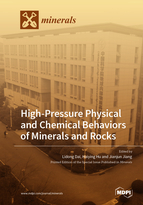High-Pressure Physical and Chemical Behaviors of Minerals and Rocks
A special issue of Minerals (ISSN 2075-163X). This special issue belongs to the section "Crystallography and Physical Chemistry of Minerals & Nanominerals".
Deadline for manuscript submissions: closed (24 February 2023) | Viewed by 22678
Special Issue Editors
Interests: electrical properties of mineral and rock; spectroscopy property measurements; X-Ray diffraction for synchrotron; scanning electron microscope; high-temperature; high-pressure
Interests: electrical conductivity; spectroscopy properties; mineral; rock; high pressure
Interests: synchrotron X-ray diffraction; sample thesis; mineral; rock; high pressure
* Dr. Jianjun Jiang passed away before the Special Issue is closed.
Special Issue Information
Dear Colleagues,
The 8th “From Atom to Earth” Symposium on High-pressure Science and Earth Science will be held in Guiyang, China between 2–5 July 2021. Participants from Chinese top colleges and research institutions will gather together to mainly discuss the new progress in the field of physical and chemical behaviors of minerals and rocks under high-temperature and high-pressure conditions. This Special Issue of Minerals will provide an opportunity to deeply display new developments in high-pressure mineral physics. We invite attendees of the 8th “From Atom to Earth” Symposium on High-pressure Science and Earth Science to submit their high-quality manuscripts to this Special Issue. Suitable contributions from other interested professionals are also welcome.
The first round submission deadline is 5 November 2021.
Dr. Lidong Dai
Dr. Haiying Hu
Dr. Jianjun Jiang
Guest Editors
Manuscript Submission Information
Manuscripts should be submitted online at www.mdpi.com by registering and logging in to this website. Once you are registered, click here to go to the submission form. Manuscripts can be submitted until the deadline. All submissions that pass pre-check are peer-reviewed. Accepted papers will be published continuously in the journal (as soon as accepted) and will be listed together on the special issue website. Research articles, review articles as well as short communications are invited. For planned papers, a title and short abstract (about 100 words) can be sent to the Editorial Office for announcement on this website.
Submitted manuscripts should not have been published previously, nor be under consideration for publication elsewhere (except conference proceedings papers). All manuscripts are thoroughly refereed through a single-blind peer-review process. A guide for authors and other relevant information for submission of manuscripts is available on the Instructions for Authors page. Minerals is an international peer-reviewed open access monthly journal published by MDPI.
Please visit the Instructions for Authors page before submitting a manuscript. The Article Processing Charge (APC) for publication in this open access journal is 2400 CHF (Swiss Francs). Submitted papers should be well formatted and use good English. Authors may use MDPI's English editing service prior to publication or during author revisions.
Keywords
- high-pressure electrical conductivity
- high-pressure elastic wave velocity
- high-pressure spectroscopy
- high-pressure synchrotron X-ray diffraction
- high-pressure thermophysical property
- high-pressure theoretical calculation
- high-pressure new technique breakthrough
- high-pressure Earth and planetary science
- high-pressure application








